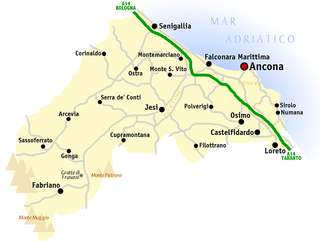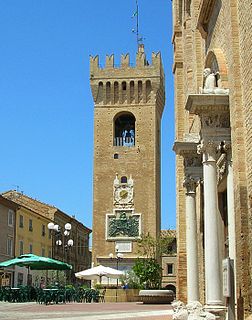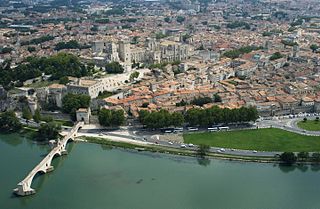
Lorenzo Lotto was an Italian painter, draughtsman and illustrator, traditionally placed in the Venetian school, though much of his career was spent in other North Italian cities. He painted mainly altarpieces, religious subjects and portraits. He was active during the High Renaissance and the first half of the Mannerist period, but his work maintained a generally similar High Renaissance style throughout his career, although his nervous and eccentric posings and distortions represented a transitional stage to the Florentine and Roman Mannerists.

Carlo Crivelli was an Italian Renaissance painter of conservative Late Gothic decorative sensibility, who spent his early years in the Veneto, where he absorbed influences from the Vivarini, Squarcione and Mantegna. He left the Veneto by 1458 and spent most of the remainder of his career in the March of Ancona, where he developed a distinctive personal style that contrasts with that of his Venetian contemporary Giovanni Bellini.
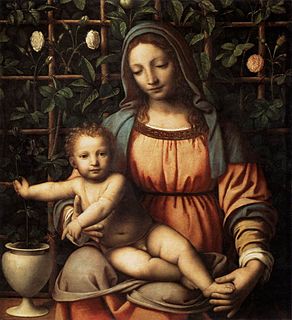
Bernardino Luini was a North Italian painter from Leonardo's circle during the High Renaissance. Both Luini and Giovanni Antonio Boltraffio were said to have worked with Leonardo directly; he was described as having taken "as much from Leonardo as his native roots enabled him to comprehend". Consequently, many of his works were attributed to Leonardo. He was known especially for his graceful female figures with elongated eyes, called Luinesque by Vladimir Nabokov.
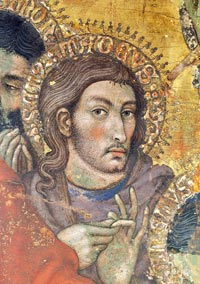
Taddeo di Bartolo, also known as Taddeo Bartoli, was an Italian painter of the Sienese School during the early Renaissance. He is among the artists profiled in Vasari's biographies of artists or Vite. Vasari claims he is the uncle of Domenico di Bartolo.

Cristoforo Roncalli was an Italian mannerist painter. He was one of the three painters known as Pomarancio or "Il Pomarancio.

Lorenzo di Niccolò or Lorenzo di Niccolò di Martino was an Italian painter who was active in Florence from 1391 to 1412. This early Renaissance artist worked in the Trecento style, and his work maintains influences of the Gothic style, marking a transitional period between the Gothic sensibilities of the Middle Ages while simultaneously beginning to draw on the Classical. Lorenzo's works were usually religious scenes in tempera with gold backgrounds.

Lippo Memmi was an Italian painter from Siena. He was the foremost follower of Simone Martini, who was his brother-in-law.
The decade of the 1420s in art involved some significant events.
The decade of the 1430s in art involved some significant events.

Giampietrino, probably Giovanni Pietro Rizzoli, was a north Italian painter of the Lombard school and Leonardo's circle, succinctly characterized by Sidney J. Freedberg as an "exploiter of Leonardo's repertory."

The Master of the Bambino Vispo was a central-Italian painter active in the early 15th century.
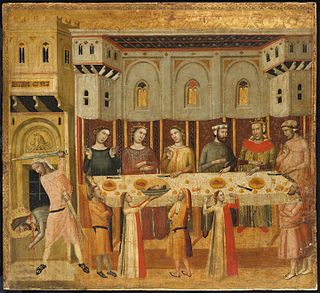
Giovanni Baronzio, also known as Giovanni da Rimini,, was an Italian painter who was active in Romagna and the Marche region during the second quarter of the 14th century. His year of birth is unknown. Giovanni Baronzio was the eminent representative of the second generation of painters of the school of Rimini who were influenced in by the activity of Giotto in Rimini.
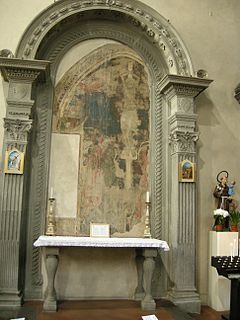
Pietro di Miniato or Pietro di San Miniato was an Italian painter, active in Florence and Prato, in a Gothic style. He collaborated with a relative Antonio di Miniato di Piero, likely his son, active circa 1430 in and around Prato. Among the works attributed to him are a painted crucifix in the St Louis Museum of Art, a polyptych in the Museo Civico of Prato, a painted mural in the church of San Niccolò da Bari in Prato, and a mural in the Chapel of San Stefano of the Duomo di Prato, depicting the Virgin and child flanked by saints.

The Master of Pratovecchio was an Italian painter of the Renaissance, named by Roberto Longhi in a 1952 article on the basis of stylistic similarities of a number of works to an altarpiece painted for the monastery of San Giovanni Evangelista in Pratovecchio. The centre panel of the triptych, depicting the Assumption of the Virgin is currently on deposit in Arrezo; the left and right side-panels are in the National Gallery, London.
San Marco Evangelista is a Roman Catholic church in the town of Osimo, region of Marche, Italy.
Paolo Bontulli was an Italian painter, mainly of sacred subjects.
Santa Maria Assunta di Castelnuovo is a Roman Catholic church located on Via Angelo Giunta in the town limits of Recanati, province of Macerata, in the region of Marche, Italy. It is the oldest church structure in town.
Luca di Paolo was an Italian painter mainly active in Matelica in the Marche region.

The Museo Civico di Montepulciano, also known as the Museo Civico Pinacoteca Crociani, is the town or comune art gallery and museum. It is housed in the medieval Palazzo Neri Orselli, a 14th-century structure located on Via Ricci #10, corner with Via Talosa, in the center of the town of Montepulciano, in the Province of Siena, region of Tuscany, Italy. The museum was founded in 1954.



